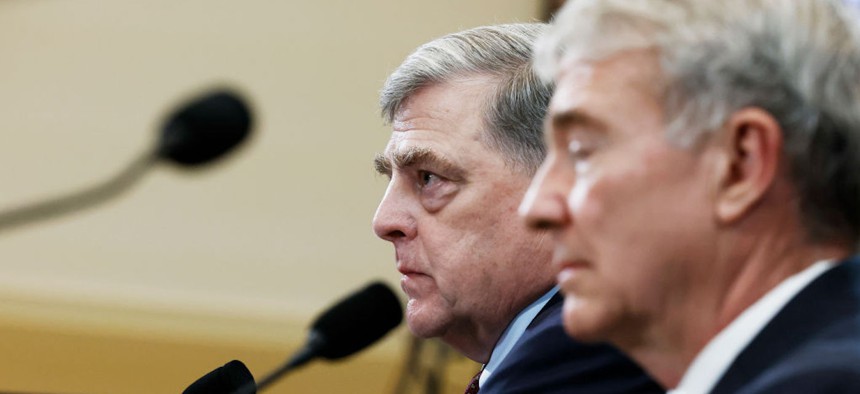
Former Chairman of the Joint Chiefs of Staff Mark Milley (L) and former Commander of the United States Central Command Kenneth F. McKenzie Jr., (R) participate in a hearing with the House Foreign Affairs Committee on March 19, 2024. Anna Moneymaker / Getty Images
Milley, McKenzie detail mistakes that led to Afghan evacuation chaos
The retired generals blamed the State Department for the debacle at Hamid Karzai airport. But it’s not that simple.
In Shakespeare’s Hamlet, the demise of the protagonist's father sets the play in motion, making him one of the most important characters in literature to never grace a stage. So it was with Tuesday’s hearing on the chaotic U.S. evacuation from Afghanistan in 2021. For almost four hours, lawmakers grilled Mark Milley, former chairman of the Joint Chiefs, and Kenneth McKenzie, former head of U.S. Central Command, about the mistakes that led to the deaths of 13 Americans and hundreds of Afghan allies.
But several key figures were missing from the proceedings, including the current U.S. president and his predecessor, their secretaries of state, the chief U.S. negotiator with the Taliban, and Afghanistan’s former president, who fled the country as the Taliban closed in on Kabul.
Still, the message from the two retired generals was clear: the U.S. military had performed as well as could be expected in its final days in Afghanistan. Others, not so much.
McKenzie said the chaos was due in large part to State Department foot-dragging before it ordered a non-combatant evacuation operation, or NEO, on Aug. 14.
“As you are aware, the decision to begin a NEO rests with the Department of State, not the Department of Defense. Despite this, we had begun positioning forces in the region as early as 9 July, but we could do nothing to commence the operation of evacuation until NEO was declared,” Mckenzie said.
Said Milley, “The fundamental mistake, the fundamental flaw, was the timing of the State Department call of the NEO. I think that was too slow, and too late.”
But that error would not have had such a terrible effect if not for a series of other interconnected developments, the generals said. The most important of those: former Afghanistan President Ashraf Ghani’s hasty departure in the middle of August.
“As soon as the [Afghanistan Security Forces] saw that, they literally took their uniforms off, put their weapons down, and it collapsed,” Milley said. “It was very, very quick.”
The abdication had a domino effect that made the situation on the ground—particularly around the airport—far worse.
The U.S. military believed they had sufficient forces in the country to secure the airport for an evacuation in part because they thought the Afghan Security Forces would be there to back them up, McKenzie explained. The collapse of the Afghan forces forced the U.S. to bring in 6,000 additional troops. But with the exception of some special operations forces elements, U.S. forces were limited to the area immediately surrounding the airport, whereas Afghans would have been able to set up a wider security perimeter.
“We would have been able to hold [the airport] with a far smaller number of U.S. forces had the Afghans remained, but when the government collapsed, they went away. So that had a profound and immediate effect on everything else that followed,” McKenzie said.
Still, that decision by the Ghani administration was predicated on one by U.S. President Joe Biden to go beneath the number of U.S. troops that Milley and others believed was the minimum required to keep a U.S. embassy open there. Milley on Tuesday said it would have taken 5,000 troops to keep a second airfield open in Bagram, or 2,500 troops with the assistance of the Afghan Security Forces. The U.S. only had 650 in the country at the start of August.
And though Ghani’s departure played a significant role in the collapse of Afghan forces, Milley said the decision by the Trump Administration to enter into bilateral discussions with the Taliban as part of the Doha Agreement, negotiated in February 2020, was also to blame.
“Because it was negotiated between the government of the United States and a State Department-designated terrorist organization, the Taliban, and it was a bilateral agreement, that kind of pulled the rug out, morale-wise, from both the Afghan Security Forces and the government,” Milley said. “At that point, they knew…that there was a date certain, right. So I think that probably had a significant effect.”
Some defenders of the former president point out that while he negotiated an end to the U.S. military presence in Afghanistan, the agreement included conditions the Taliban had to meet before the withdrawal of U.S. troops. Of those, they only met one: not attacking U.S. troops.)
But, in new testimony, Milley said that when former President Donald Trump lost his re-election bid, he promptly came up with a new plan. [Former Defense] “Secretary [Mark] Esper was removed from office on the 9th of November. On the 11th or the 12th of November, I was handed a piece of paper with the President's signature on it, which had two sentences. One was: withdraw forces from Somalia by the 15th of December, and then withdraw forces out of Afghanistan by the 15th of January.”
Milley was able to get Trump to rescind the order shortly after, but members of Trump’s cabinet and security council were operating under several conflicting interpretations about how many troops should remain in the country, right up until Trump left the White House.
